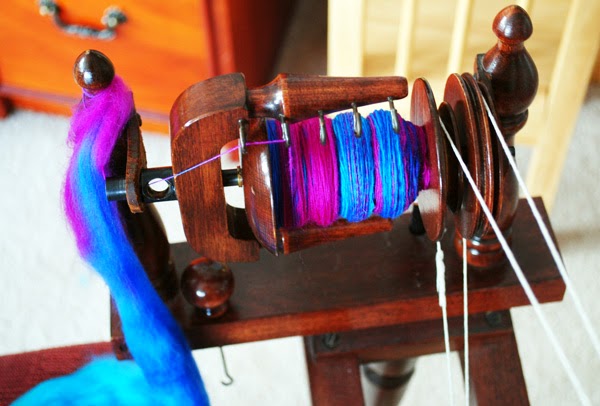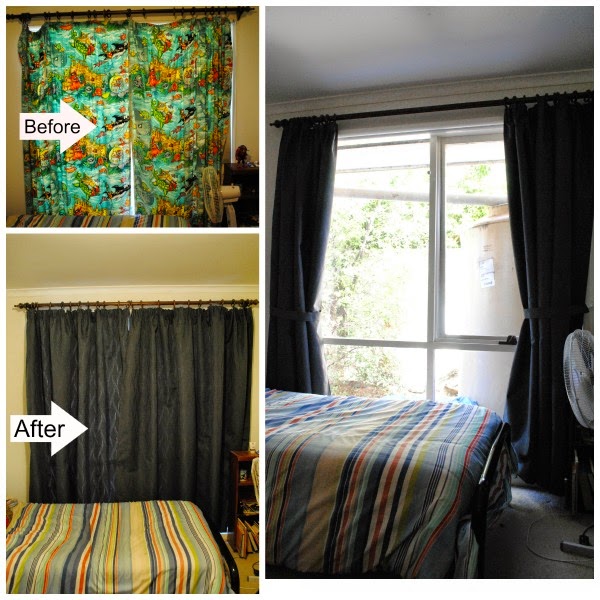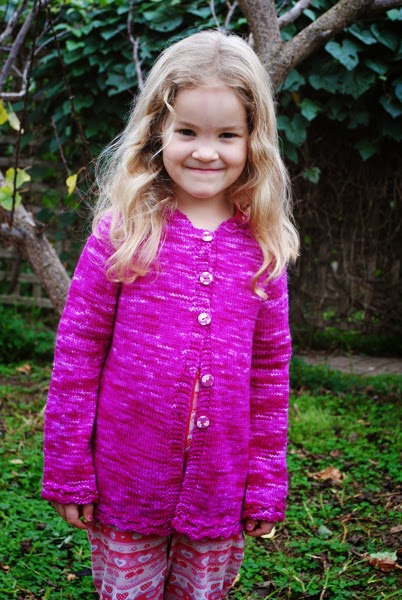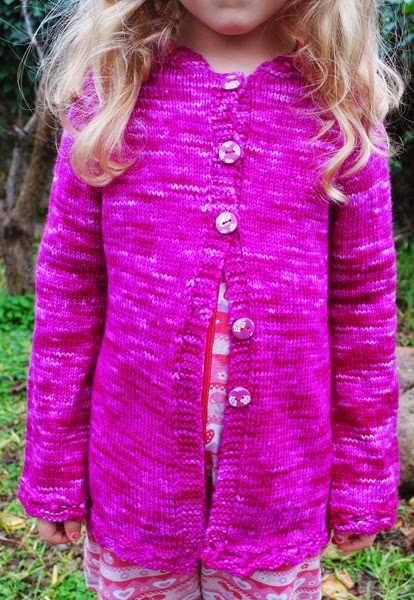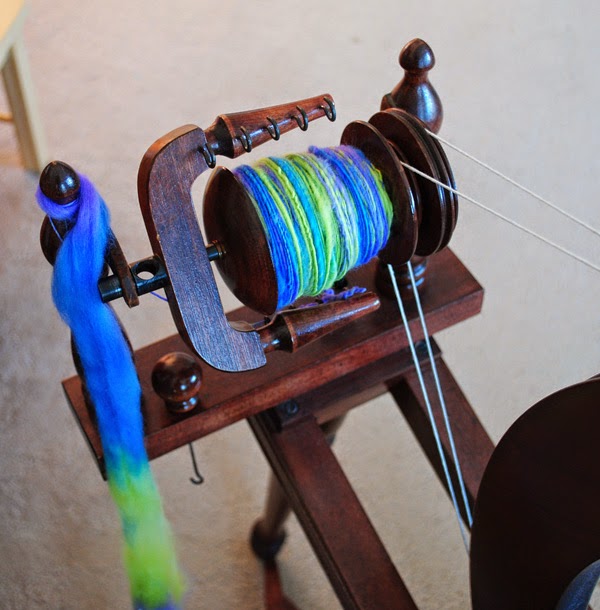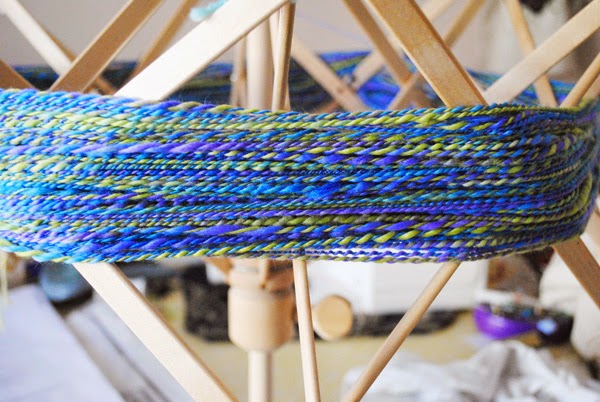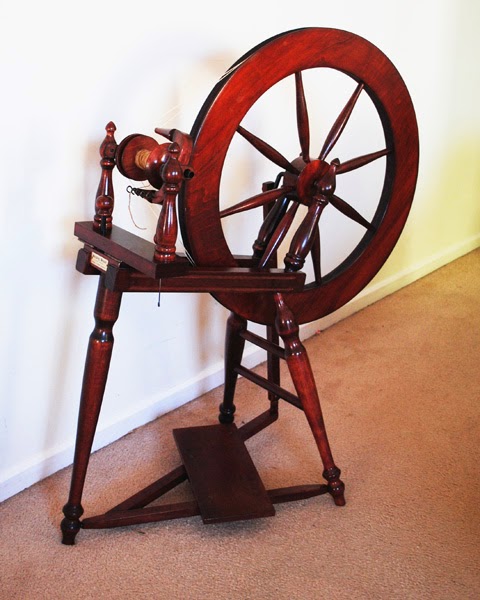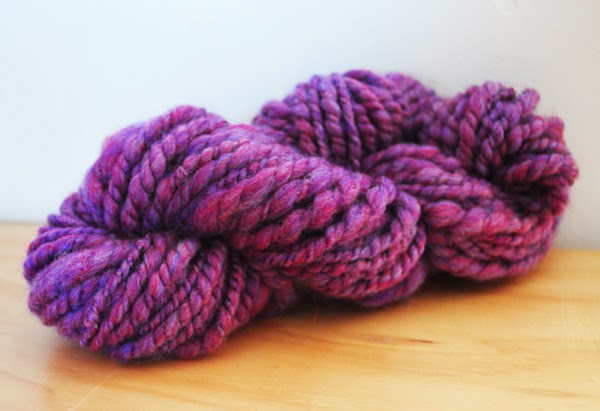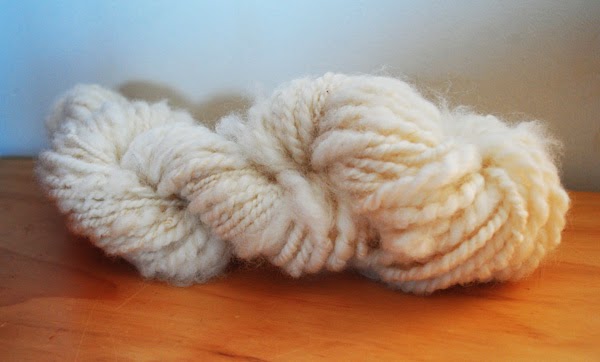Search Results for: spinning
Completed cardi and more spinning!
Beginning spinning
Weaving with a disability
Today’s guest is a very inspiring woman! Jacky is an artist and weaver from a beautiful part of the U.K, surrounded by captivating landscapes and historic buildings.
I have admired her work for some time on Instagram, where she shares wonderful photos of her artist life and her dog, Boo. In fact, when selecting photos for today’s interview, it was very difficult to narrow down to just a few, I wanted to show you so many more!

I particularly wanted to chat with Jacky on the blog so that she could share her story and experience with her physical disability and how that has impacted on her creative life.
I hope that her story will encourage you all to focus on what you CAN do, regardless of your circumstances.
How long have you been weaving? What got you interested in starting?
Just before Christmas three years ago I bought a little frame loom on a whim. I designed a little snowman wall hanging and was surprised by how well it turned out and how much I enjoyed doing it, and that’s what got me started on my weaving journey. I started looking more into weaving and that’s when I first read about rigid heddle looms – I didn’t know if I would be able to use one from my wheelchair, especially doing the warping, so did lots of research on YouTube, which is when I first saw your videos, which have been a real help for me. My Birthday was coming up, so I asked my family if I could have money instead of presents. I was so excited when I opened my first ever rigid heddle loom and couldn’t wait to get started weaving on it!
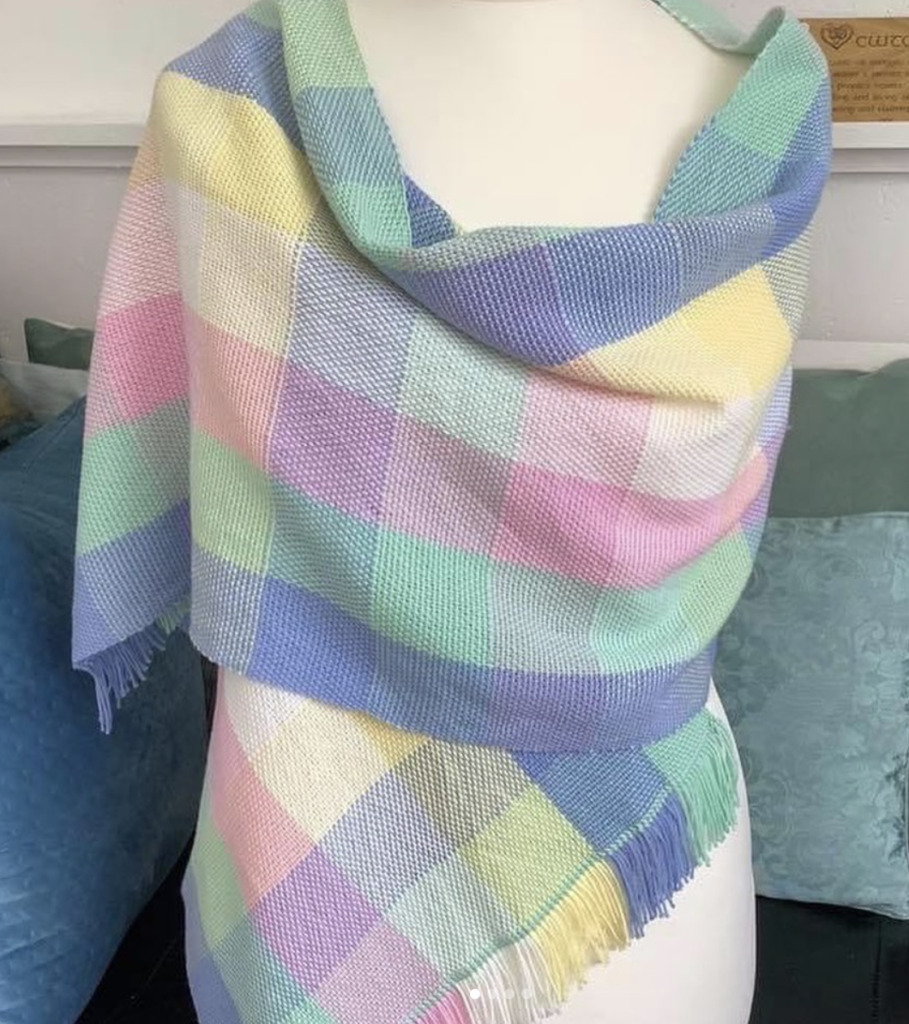
What loom/s do you own?
My first loom was an Ashford 16” RHL, but after a while I wanted something I could weave wider fabric on. I knew I wouldn’t physically manage to weave on a very wide loom so finally decided on an Ashford 24” RHL and I love weaving blankets on that. Last year I decided to add a 12” Ashford Samplet loom to my little ‘loom family’, so that I could practice more complicated weaving, and I love it! It’s such a joy to use and I can easily carry it anywhere with me.
What is your favourite fibre to work with? Do you have favourite items to weave?
Wool is definitely my favourite fibre to weave with. I always used to think wool was scratchy to wear, but now of course I have learned that there are so many types of wool, each with their own qualities. Last year I wove a scarf from a handspun blend of Blue Faced Leicester and Rose fibre and that was beautifully soft. At the moment I’m in the middle of weaving a silk scarf on the Samplet, I’ve never woven with such fine silk before and I’m really enjoying it so I think that will become another favourite.
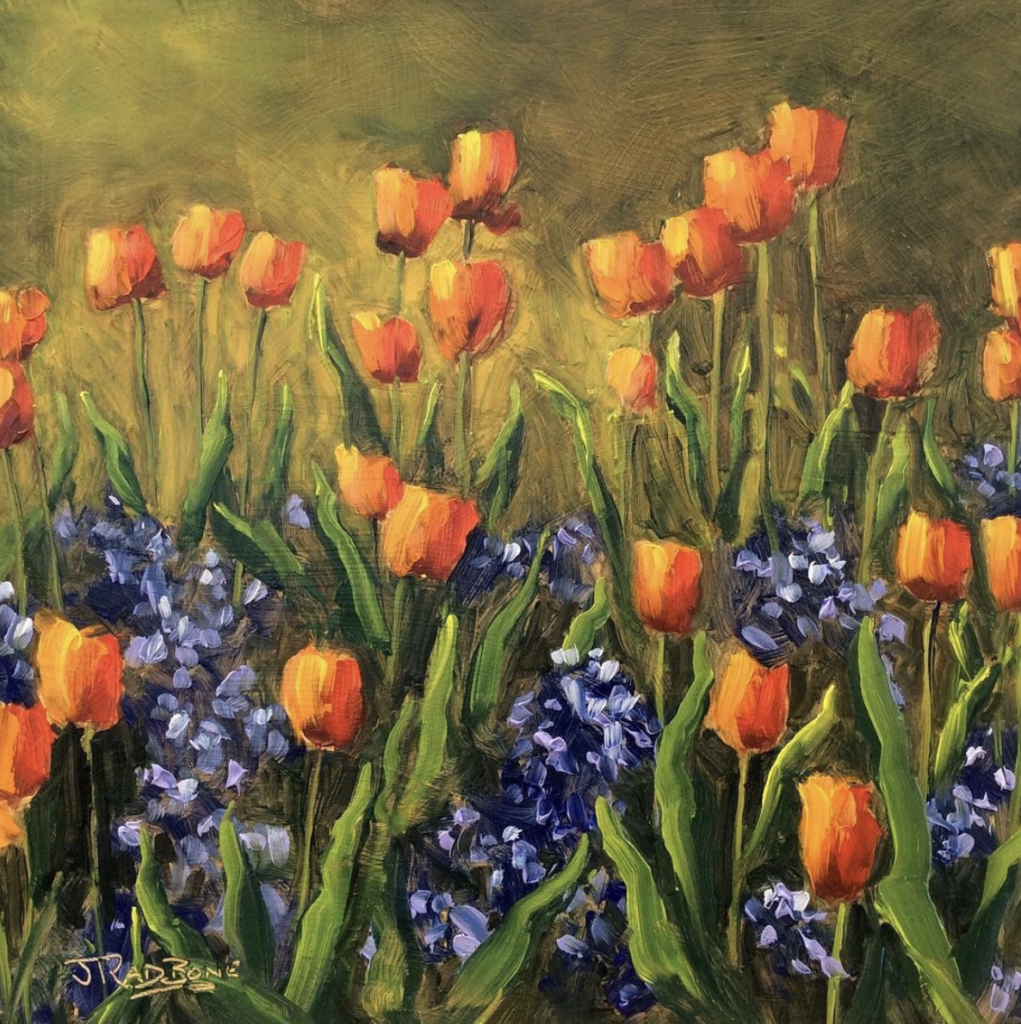
You also spend time spinning and painting. You love to paint en plein air and I find your landscapes absolutely beautiful. Do you have a favourite location/s for this?
Thank you Kelly. I’m very blessed to live in the Cotswolds which is a really lovely part of the U.K., so I’m surrounded by picturesque villages and beautiful countryside to paint in. I also love painting the sea, and my favourite coastal area is South Wales. I hope to be visiting there again soon now that our present lockdown restrictions are beginning to lift.
Please tell us about your disability and the challenges it presents to you in your creative pursuits.
I’ve been disabled with a neuromuscular illness for about 25 years now. It affects all my muscles, which are very weak, and I use an electric wheelchair to get about the house. It has left me with double vision, but I have strong prism lenses in my glasses which help quite a lot.
My arm muscles are very weak too, which is very challenging when I want to be doing things, but I make sure I take plenty of breaks to rest them for a little while when I’m weaving or painting. As long as I pace myself I usually get things done, it just takes a little bit longer.
I have to take lots of breaks when I’m warping the loom, and I’m always glad when I’ve finished doing it. My husband Phil almost always helps me with winding on the warp – I have used the ‘crank and yank’ method a few times, but it is definitely easier when he helps!

You have a beautiful assistance dog, Boo. How did you he come into your life and how has he made a difference to you?
Boo is an adorable yellow Labrador, and the gentlest dog I have ever known. He became my partner eight years ago thanks to a U.K. charity called Dogs for Good, which trains assistance dogs for people with disabilities and children with autism.
I can’t take my coat off by myself, so Boo comes by my side, gently puts one sleeve cuff between his teeth and pulls at it until my arm is free, then he goes to my other side and pulls that sleeve off too.
He also picks up everything I drop, helps to empty the washing machine and picks up the mail. He loves to come to Church with me and lies quietly by my side through the service. He has a bed in the studio and always comes to lie by my side when I’m weaving, I think he finds it as soothing as I do.
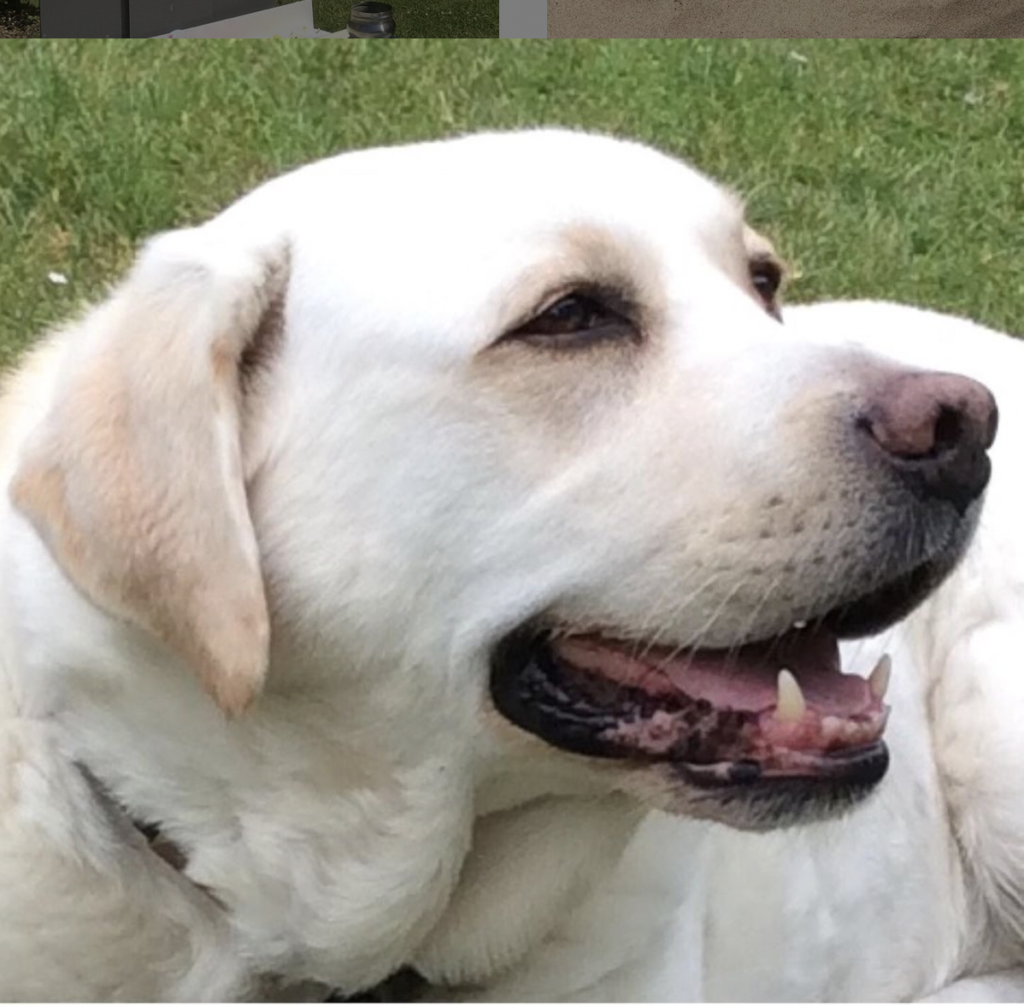
Is any of your creative work available for sale?
Most of my work is available for sale in the U.K. through my Facebook page or in exhibitions. I sell some of my woven items too, mainly scarves just now, again through Facebook. I have a stash of woven fabric waiting to be made into bags and purses, but I never seem to get round to get the sewing machine out to make them – I’d far rather be weaving!
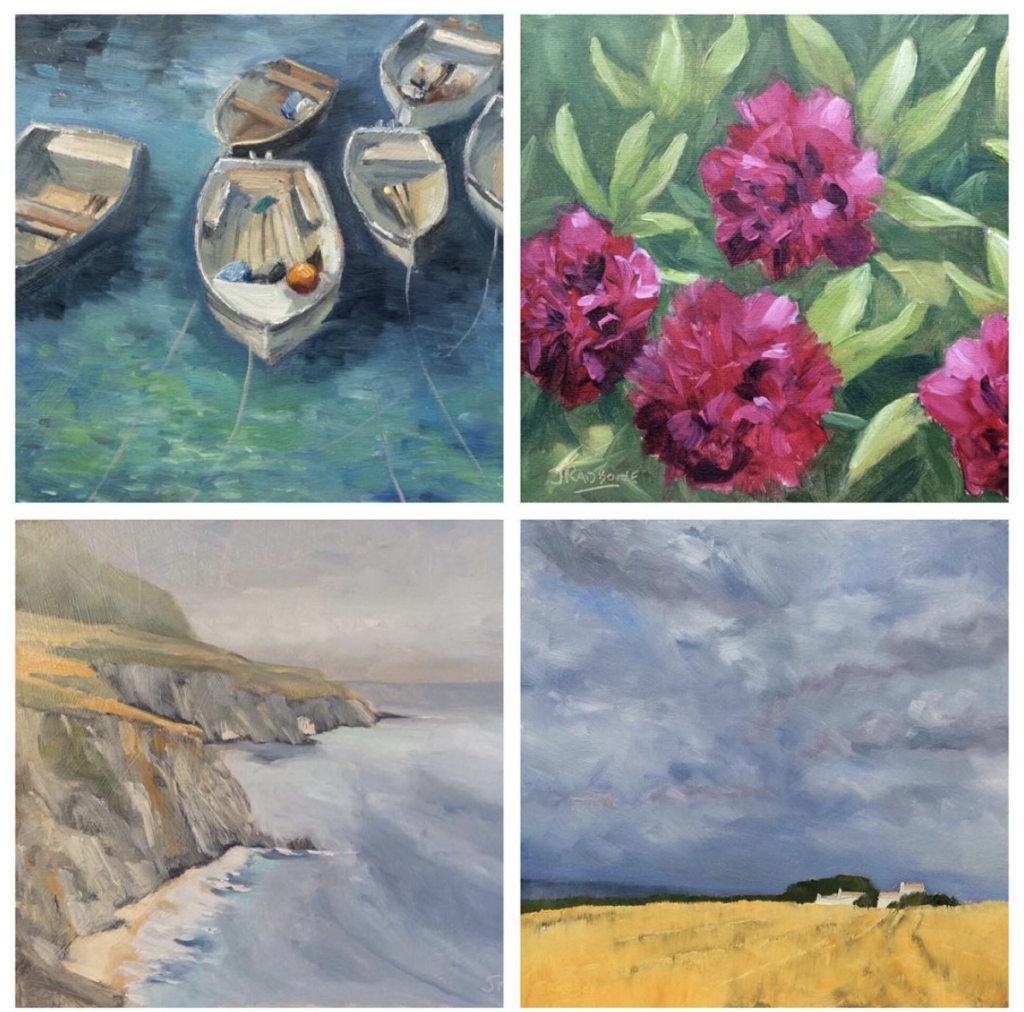
Thank you so much to Jacky for taking the time to share with us today! I know that many of you would love to follow along with her work and see what she comes up with next. You can follow Jacky here:
Facebook-
Jacky Radbone, artist
Jacky Radbone, weaving in the Little Cwtch Studio (‘Cwtch’ is a Welsh word which means ‘ a hug’)
Instagram-
Blog-
Until next time…
Happy Weaving!
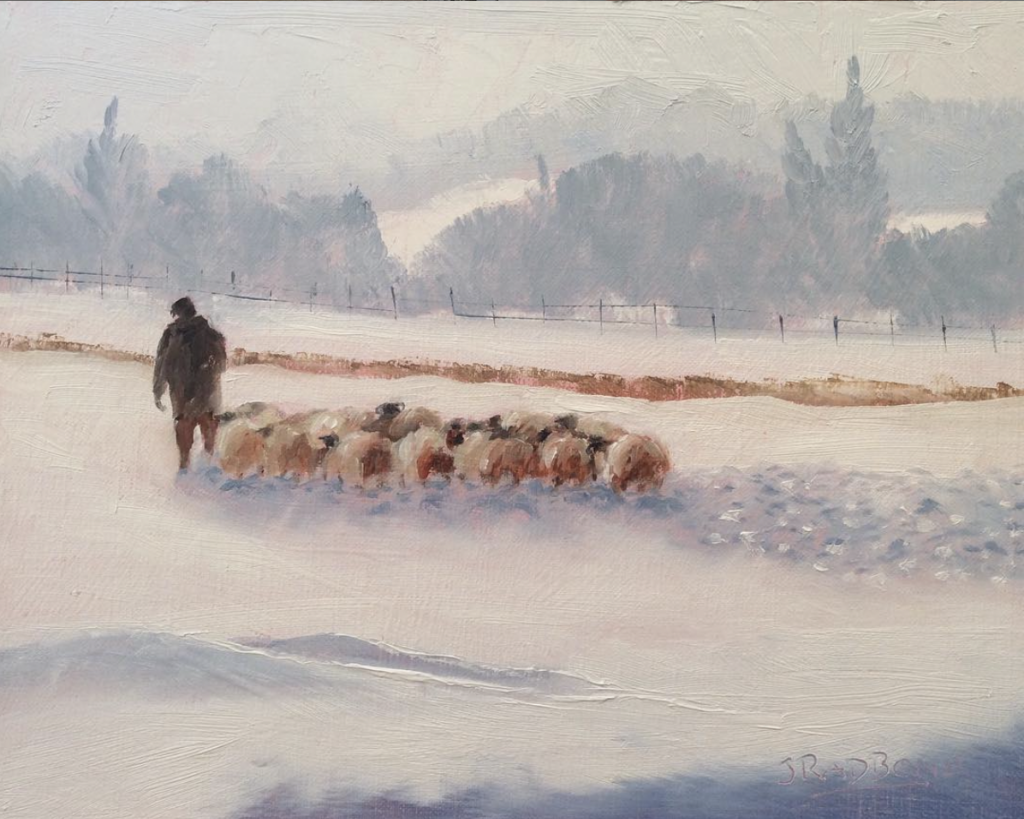
Krokbragd Patterns Interview and Giveaway!
Have you all met Debby Greenlaw before? I hope you have, but if not, you may want to read over this post where I reviewed Debby’s first book, the wonderful “Krokbragd – How to Design and Weave”.
*This post contains affiliate links. For further information, please see my disclosure policy.
I am so excited to share the news that Debby has written and released a brand new follow up krokbragd book, titled “Krokbragd Patterns”.
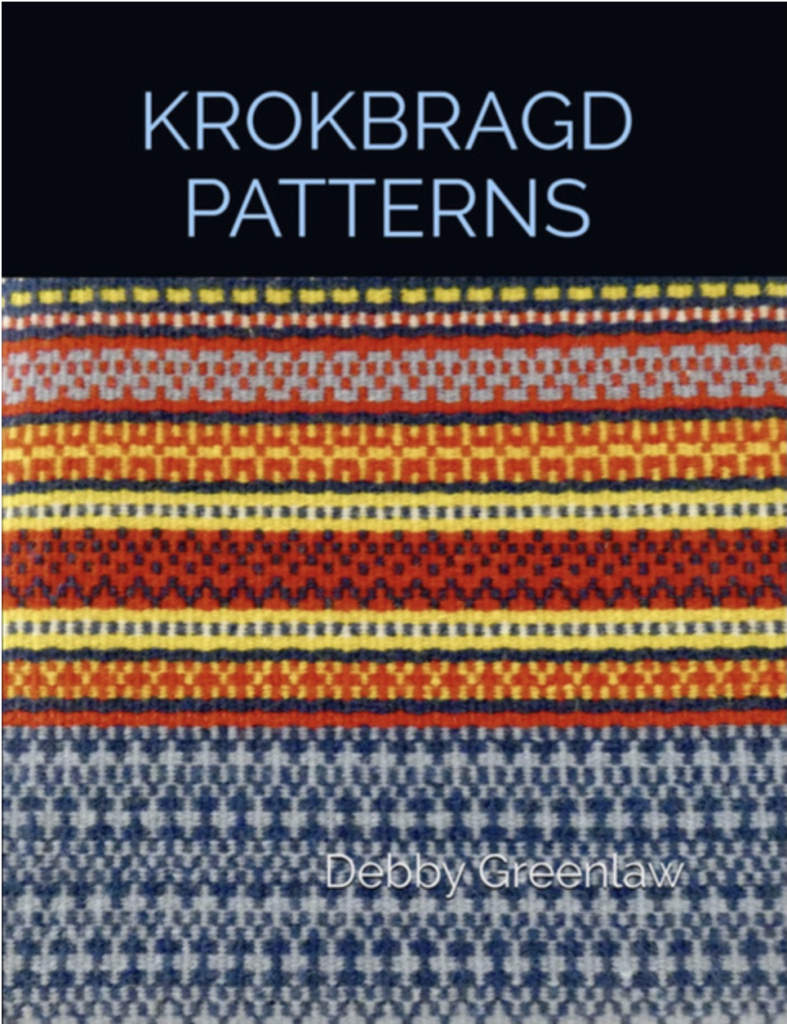
I am doubly excited to announce that, thanks to Debby’s generosity, one of you lucky readers will have the chance to win a personally signed copy of Krokbragd Patterns! Entry details are available at the end of this post.
I thought it the perfect time to have a chat with Debby so that you can all get to know her a little better and find out more about the new book, so grab a cup of tea and get comfy!
Thank you for taking the time to be my blog guest today 😊 Can you start by telling us a little about your weaving journey so far?
“Weaving was my entry into the wonderful world of fiber arts. I am a relatively “late bloomer” in this area, not starting the journey until I retired in 2016 after a 40+ year career as a nurse/nurse practitioner. I purchased an Ashford Sampleit loom at a local fiber festival just to see if I would like this weaving thing . . . I loved it. That lead to a floor loom, a dye garden, a spinning wheel, and eventually knitting needles and crochet hooks!”
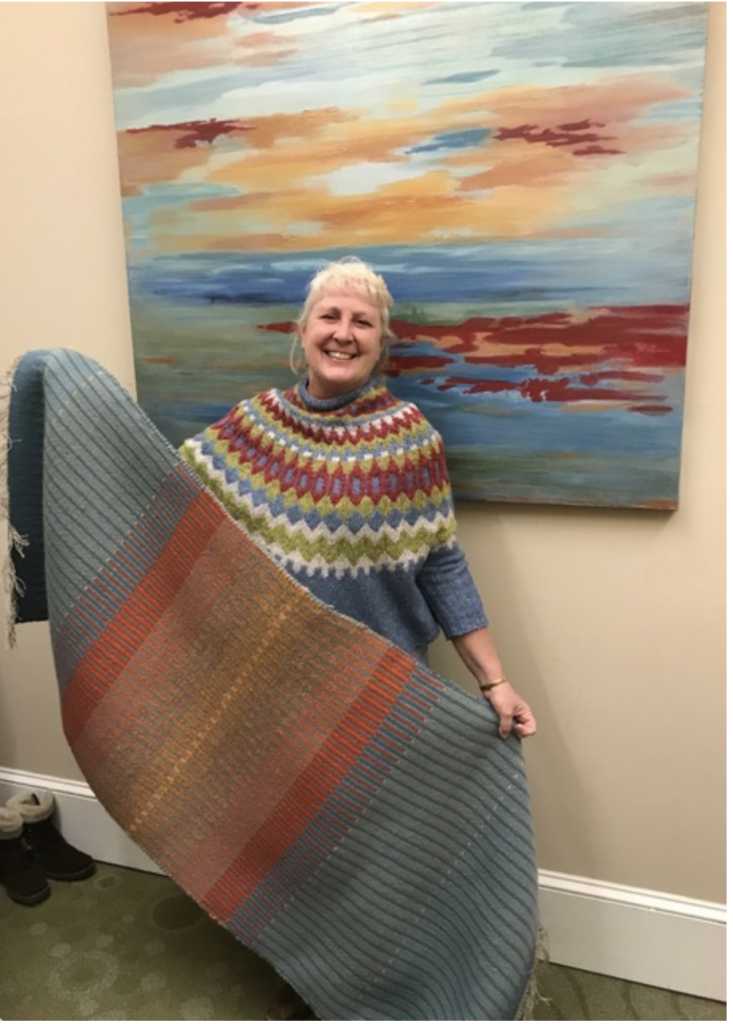
What looms do you have and which one gets the most use?
“I have a Leclerc Nilus 4-shaft floor loom, a Kromski Harp Forte rigid heddle, and a Louët Jane 8-shaft table loom. By far the Jane gets used the most!“
You are perhaps most well known for your krokbragd weaving. What is about krokbragd that you love?
“First, I’m drawn to the Scandinavian aesthetic. My heritage says I’m German through and through, but I think there must be some Norse hidden in there. I love the simplicity of design and the color combinations of Scandinavian weaving. Krokbragd embodies both of those characteristics.”

Your first book, “Krokbragd: How to Design and Weave” had been immensely popular. What lead you to write a book all about krokbragd?
“Simply, there wasn’t a book written on the subject. In fact, several years ago, there were very limited resources available on krokbragd. I saw a social media post that said, “someone should write a book,” and I thought I can do that!”
You are just about to release your second book, “Krokbragd Patterns”. Did you decide to write a follow up book based on the feedback received from your first book? What excites you the most about this book?
“You’re absolutely correct. I received emails, comments, and even a review asking for a krokbragd pattern book.
Hmmm . . . what excites me the most. It would have to be the test weavers. Eighteen delightful women answered my request to be test weavers for the book’s projects. Seeing my designs come alive in their talented hand was so exciting. Their feedback, enthusiasm, and encouragement were invaluable to me during the designing and writing process.”
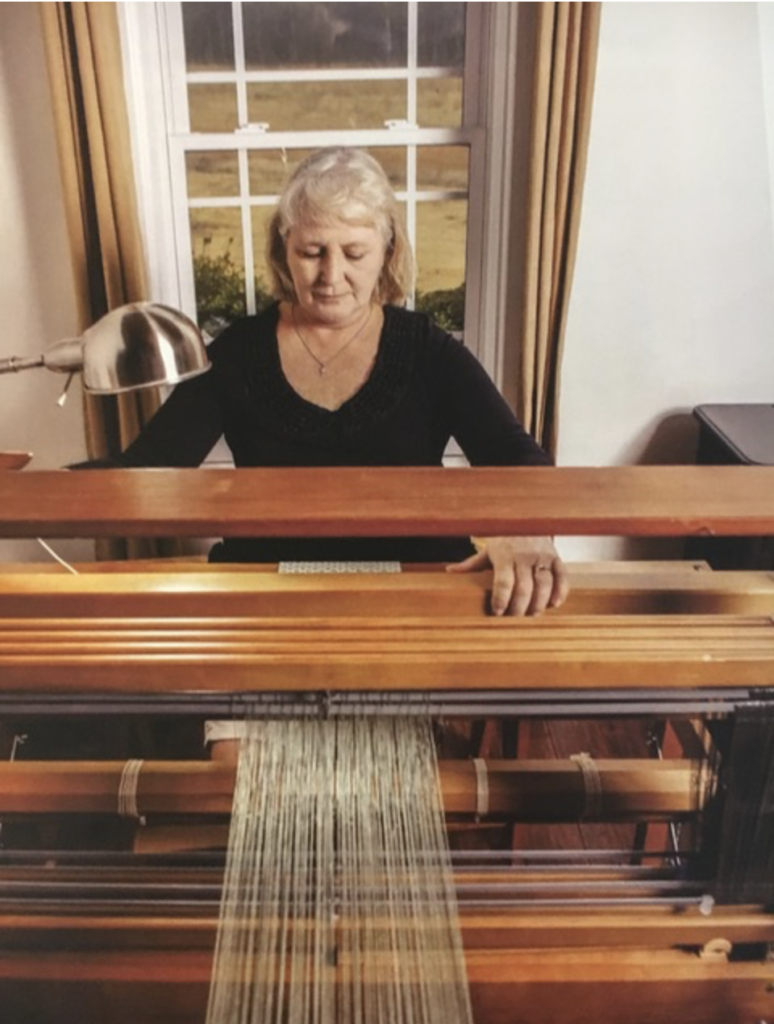
You are blessed to live in a beautiful location. How do you most enjoy spending your days? What should visitors to your region look out for as a “must do”?
“God has graciously blessed my husband and me with a beautiful place to live, a small farm in rural South Carolina. We share our space with 21 dairy goats, a mini donkey, chickens, a barn kitty, and a playful pup! There are many routine farm chores to keep up with, along with the occasional urgency/emergency. I’ve found my nurse practitioner skills translate well to farm animals! In addition to fiber arts, I also like to garden.
South Carolina is diverse in natural beauty. It is one of the smaller U.S. states but stretches from the seashore to the mountains. It is also rich in history and historical sites and gardens.”
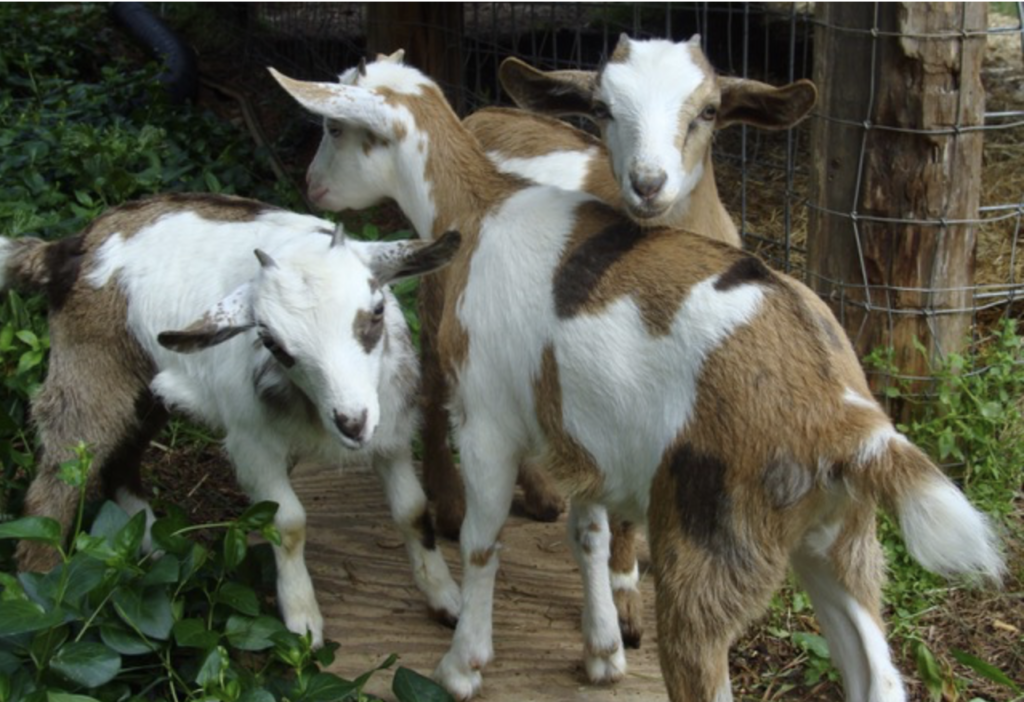
You can find more great weaving information on Debby’s blog, Flora & Fiber. Books can be purchased through the blog, on Amazon or in selected stores.
Purchase Krokbragd – How to Design and Weave
Now, about that giveaway! To enter, leave a comment below that describes why you would love to win a signed copy of Krokbragd Patterns. If your comment doesn’t show up right away, don’t worry, I will approve it when I see it (I have to keep those spammers at bay!)
Open to anyone worldwide.
I will draw the lucky winner on the Saturday 17th of April, 2021.
- THE GIVEAWAY HAS NOW CLOSED. CONGRATULATIONS TO THE WINNER, CHERI SUTHERLAND!
Until next time…
Happy Weaving!
Online Weaving School 3 year anniversary giveaway!
It’s hard to believe that 3 years have passed since I began my Online Weaving School. Many of you have been with me for all of that time and longer, but if you’re new here, I’d like to tell you a little about my teaching journey.
*This post contains affiliate links
I’ve always been a creative person but making things with my hands became more important to me when I found myself an at home Mum with 4 children. The urge to relax and create became very strong and somewhat vital. I needed that quiet, meditative time away from my regular daily duties.
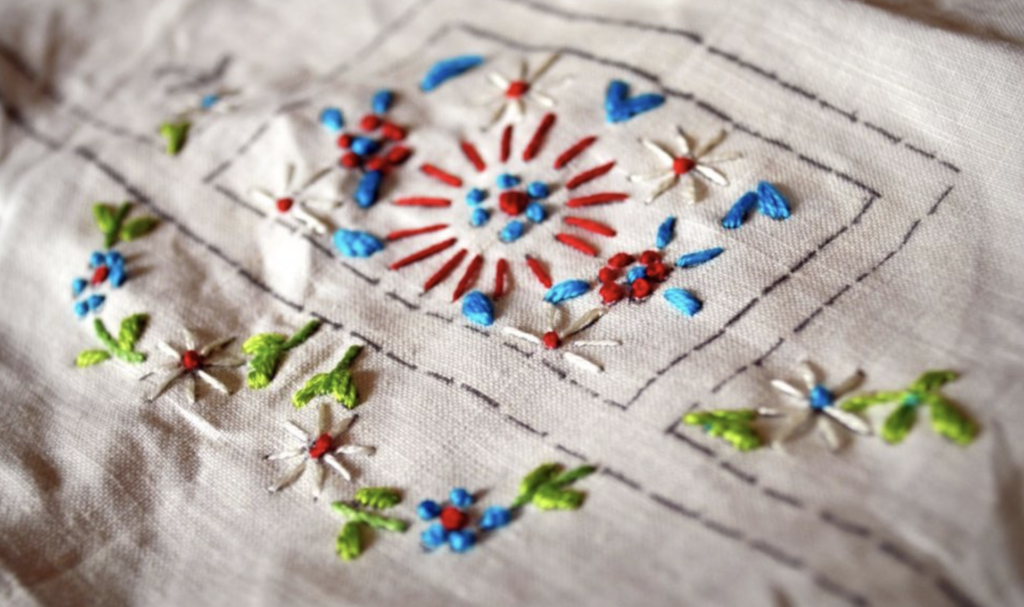
I started with embroidery after my mother in law gifted me with some vintage supplies. Then I got a sewing machine and started sewing clothes for my kids. From there I started making dolls. This began my relationship with Etsy, where I sold my dolls. Then bear making, quilting, knitting, spinning, dyeing and weaving. Many of these were learned books, some from just teaching myself and some (especially knitting) from Youtube. Youtube was just becoming a thing at that time. When I came to weaving, I found it the perfect culmination of so many of the arts and skills I had already been practicing for years. When I found weaving, I felt like I had come home.
After I had been weaving for some time and felt very confident at my rigid heddle loom, I felt that I really wanted to share some of the wonderful things I had learned. I was almost bursting with excitement and passion but I didn’t know any other weavers at all.
So I made a video and uploaded it to Youtube. I didn’t know anything about how to teach or how to use Youtube. My son helped me to film and edit to make the video passable. I expected nothing, I didn’t even think about whether anyone would be interested. I just thought it might help someone and I wanted to share.
As it turns out, that video is still helping weavers, 5 years later! People loved the video and asked for more. I made more. And I loved it. It was so rewarding to know that I could help others and share this passion for weaving.
After a while, my Youtube hobby was starting to cost a lot of money in materials and the meagre income from Youtube ads didn’t even begin to cover the expense. I was a stay at home Mum, homeschooling her children and relying on my husband to earn enough income to keep us fed and clothed.
So, using a Youtube paid channel, I started to (gasp! how could I even dare to!) charge for classes. This was a big mind shift for me. People wanted to pay me in exchange for classes!! I still ran my free channel, but the paid channel was a huge blessing. Now at least I could cover my expenses, even if I still wasn’t really earning anything extra. When the Youtube paid channels ceased to exist, I had a fairly sizeable following of enthusiastic weavers. And they still wanted more! So, I found Teachable and set up my tiny Online Weaving School and community.
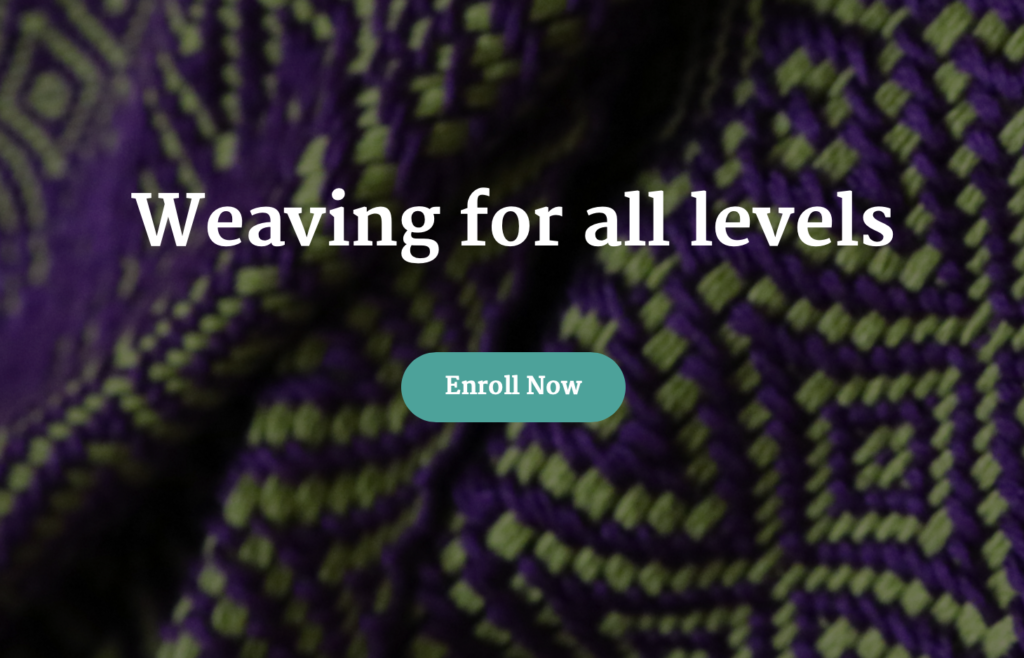
3 years later, that “tiny” weaving school has grown to over 4000 registered users and 750 paid memberships and is still growing! I am still pinching myself. Thanks to the constant support from my wonderful and loyal students, I now provide the income for my family of 6. This is something I never would have dreamed could happen and I have learned so much. I would go so far as to say that having my weaving school has transformed me as a person – or perhaps better to say, it has formed me into the person I was meant to be.
Aside from all of the obvious benefits the success of the school has brought me are the less obvious blessings. The beautiful friendships and relationships I’ve encountered with weavers all over the world. The ability to help others not just to learn to weave, but to share other difficult life burdens. It is amazing to be in a position where you feel you can truly make a difference to the lives of others!
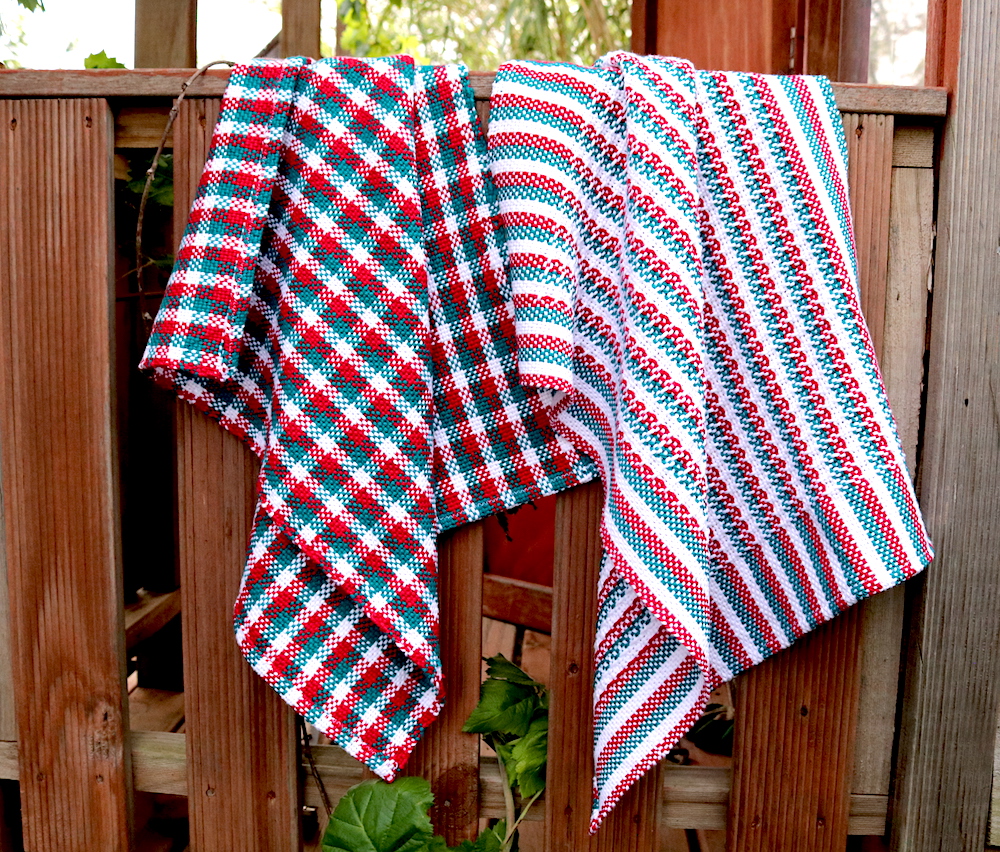
If you already know or follow me, then you will be aware of my recent free project, The Wash Your Hands Towels. I designed these towels in the time of uncertainty while the world was suffering from the effects (and still is) of the coronavirus pandemic. This has been a hugely popular project and seemed to come at just the right time for many weavers at home under lockdown. I’ve seen lots of different versions completed in a big variety of colours, it’s been wonderful to see.
So, I thought a very appropriate way to celebrate this 3 year milestone would be to give away a Wash Your Hands Towels Kit. This kit will be a one off, as I don’t have plans to make kits available for sale.
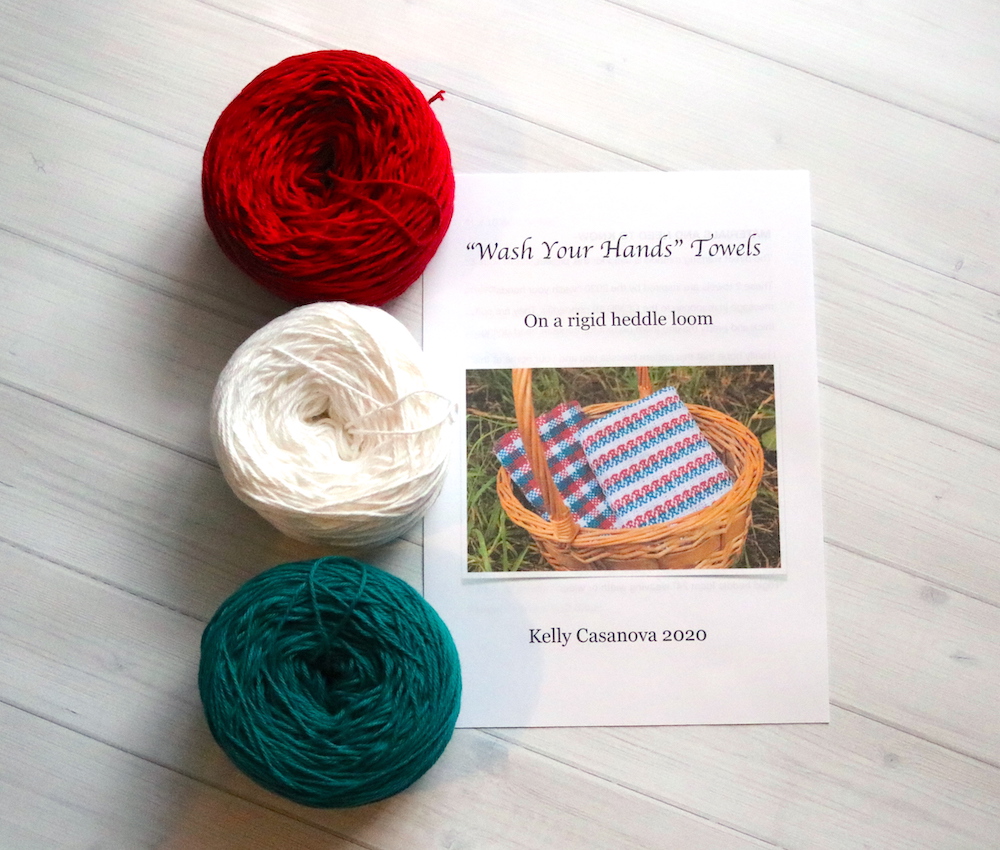
Included in the kit is all the beautiful Australian cotton yarn you need to make two towels plus a paper printed PDF. You use the PDF in conjunction with the video tutorial. If you wish to know what you need to complete this rigid heddle project, read this post that has all the details.
This giveaway is open to all, wherever you happen to be in the world. Entries are open until the end of this month of May 2020.

To enter the giveaway, please leave me a comment here (only comments on this blog post will be considered entries) and tell me why you would like to win.
Make sure you are on my email list to keep up to date with the giveaway and for the winner announcement.
I look forward to reading all your comments and drawing a winner!
THIS GIVEAWAY IS NOW CLOSED. CONGRATULATIONS TO THE WINNER – VEENA RAGHAVEN!
Until next time…
Happy Weaving!
Heritage Crafts and Skills Book Review
My thanks to Pen and Sword Books for asking me to review Lynn Huggins- Cooper’s new book “Spinning and Weaving”.
Disclaimer – Although I received no payment for this post, Pen and Sword generously sent me a copy of the book for free.
This is not an instructional book, but an historical account of spinning and weaving throughout various periods in time.
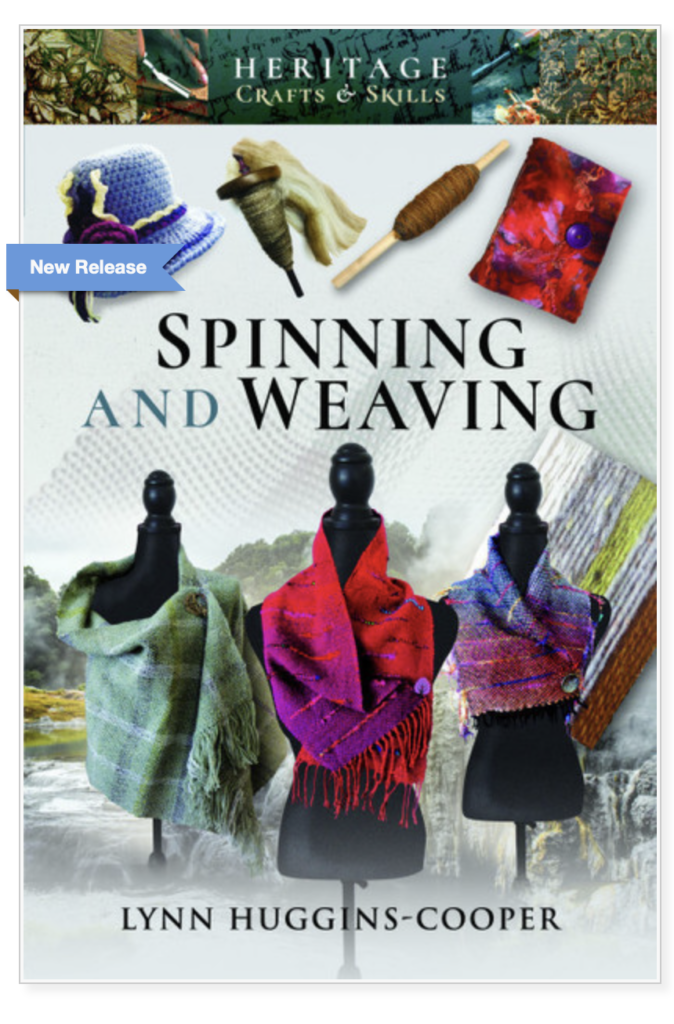
It begins with a discussion of heritage crafts in the UK and their general decline, something which is obviously close to the author’s heart. It is quite focused on the history of spinning and weaving in the UK, particularly in later periods of time.
Starting with ancient times, the reader is taken on a journey of what is know of spinning and weaving and the significance of these crafts on our civilisation. From the basic tools of drop spindles and homemade looms, to the advances in technology, which ultimately completely changed the cloth industry, each chapter is a fascinating insight into times gone by.
I found so many interesting tidbits to ponder over whilst reading this book. I also learned many things I didn’t previously know or had not really thought about. For example, the massive impact that the mechanisation of spinning and weaving had on the poor, who relied so heavily on the slow, skilled process of basic wheels and looms to earn their bread. How the demand for commercially produced fabric impacted lifestyles and how fabric was viewed.
It is sad to know that the spinners and weavers who were so valued and made first class fabric for wealthy folk were made obsolete by machines. And yet, was it fair that only the rich could afford handspun and woven cloth?
What pleased me most in the reading of this book was the realisation that, perhaps, in a way, things have come full circle. Yes, we live in a very commercialised world but it is also a world full of opportunities. We still have machines producing millions of yards of cloth every year, but we also have people like you and me, who have chosen to take up our wheels and looms in pursuit of authenticity, quality and satisfaction in our work. And thankfully, more and more all the time, we have an audience who appreciate what we do and who also desire quality, slow and beautifully made unique garments and pieces.
The book finishes off with some inspiring interviews with fibre artists (I noticed there was even an Australian included!)
I feel so blessed to be a part of something that many of our ancestors (my ancestors were English) earned their living by and now, we have the luxury of choosing to do. It’s a wonderful thing to be able to practice these crafts and pass them on to the next generation.
“Spinning and Weaving” is available from the Pen and Sword website and also on Amazon (affiliate link).
Until next time…
Happy Weaving!
Interview with Felicia Lo from Sweet Georgia Yarns
Today I’d like to introduce you to the lovely Felicia, who grew a successful yarn company from the humble beginnings of a small blog. I love Felicia’s adventurous spirit when it comes to all things fibre and how she continues to learn, explore and create. She also happens to have possibly the cutest two kids I’ve ever seen!
You have a strong interest in more than one type of fibre art. Can you tell us about some of them?
“Yes! Sometimes I wish I could streamline my making and narrow my focus to just one fibre art… but I really do love the interaction of weaving, spinning, dyeing, and knitting. If you’re going to weave, you’ll need yarn… and what’s better than weaving with yarn that you dyed yourself or even yarn that you spun from fibre that you dyed? It’s so powerful to be able to control and affect the finished object at so many levels and can open up your creative possibilities. So the things I make tend to take longer since I want to be involved in the dyeing and weaving processes at the very least. And since colour is so significant as a personal expression, I feel like the work doesn’t have my “signature” on it if the yarn isn’t hand-dyed.

And while we create hand-dyed yarns and fibres at SweetGeorgia, knitting with hand-dyed yarns is really my hobby. I nearly always have a project with me for car rides, soccer practice, swimming lessons, and Netflix nights.”
What attracted you to weaving? How did you learn?
“When I think back, I remember my parents giving me a Fisher Price toy loom when I was a kid. It was basically a rigid heddle loom and it was AWESOME. I remember weaving really thick white acrylic yarn and making a fabric that I hand sewed into a tiny purse. It wasn’t pretty, but I was so young, I just thought it was magic to be able to make something like that.
It wasn’t until I was almost 30 when I actually started to weave. It was actually my spinning teacher that gently enabled me to really start weaving. She taught both spinning and weaving at a school here in the Vancouver area. I took the spinning classes in a room that was FILLED with floor looms. It was inspiring and the itch to weave was inescapable. Originally she told me that weaving used up lots of yarn and since I was making tons of hand-dyed yarn, I just thought it would be a great way of using up yarn.
I joined the weaving class and remember learning how to wind a warp, how to dress a loom back to front, and then for one of my first projects, I wove a silk scarf from yarn that had been handpainted. Every part of the process felt addictive — threading the heddles, sleying the reed, tying onto the front apron rod, throwing the shuttle — all of it was addictive and I was always craving a little bit more. “
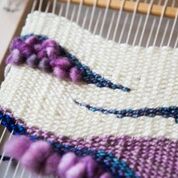
How did SweetGeorgia Yarns come about?
“SweetGeorgia happened quite unintentionally. It was 2004 and I was a web developer at the time and I was familiar with blogs, but didn’t realize there was a growing community of knitting bloggers until I started searching Google for information about this Rowan sweater design I wanted to knit (it’s this sweater, if you’re curious: https://www.ravelry.com/patterns/library/audrey). Turns out there was a “knit along” for this sweater design and knitters from all over the world were knitting this pattern, taking photos of it, writing about their process, and documenting their successes and failures. And that’s when I realized that a blog was more than just a way of communicating or recording project details — it was (at that time) a way to participate in the greater craft community.
So of course, I started a blog so that I could also report on my Audrey sweater progress and random bread baking escapades. There were only one or two bread baking blog posts and then I continued to document my learning and experiences in knitting, dyeing, spinning, and weaving. The hand-dyeing I was doing caught the attention of the community and I found a lot of encouragement to continue dyeing and begin a little Etsy shop. So in 2005, I opened a small Etsy shop from my dining room table with three skeins of yarn. Now almost 14 years later, we have a team of about 13 people who help run our production dye studio! “

As a successful business woman who also has a young family, you must get asked the question “How do you do it all?” What are some of your strategies for balancing family, business and creative time?
“It’s funny because I’m asking every other mom/boss the same thing! I think I even asked you, Kelly, this same question over email! I can say, it’s not easy, but I try to keep a good balance of work and family life. Since my kids are still young, they go to school for part of the day and then my youngest, Nina, who is only three years old now, will join me for Tuesday and Thursday afternoons. So I squish work time into the hours when they are at school. Then when the kids are with me, I try to be present and put my work away, but we might do things like go to the dye studio together or do some craft room tidying and tasks (they like to wind balls of yarn). I generally never work on weekends or evenings anymore and I try to spend evenings with my husband, but that’s when I also try to squeeze in some knitting or weaving time.
I’ve also discovered this phenomenon where work expands to fill the time that you give it. If you give yourself 4 hours to do a job, it takes 4 hours. But if you only have 3 hours to do the same job, miraculously, it takes only 3 hours. So, I’ve started doing more “time boxing” and giving myself a set amount of time to do any one thing and the thing has to be done within that time frame (because there is no other time to do it). So, this allows me to schedule out my week and account for all the things that need to get done. For example, filming the vlog always happens on Wednesday afternoons between 3 and 4 pm, editing the vlog always happens on Thursday mornings from 9:30 to 11:30 am, and all of that needs to happen because the vlog HAS to be published at 10 am on Friday morning. It’s kind of great to give yourself this set window to work… otherwise, editing a video could easily take 8 hours if you let it and then you’ll definitely feel like there is never enough time. “
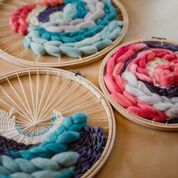
How many looms do you personally own and which is your favourite?
“It’s so hard to pick favourites! Over the years, I have acquired a few looms including an 8-shaft Louet Spring 110 cm loom, an 8-shaft Schacht Baby Wolf in cherry, a 4-shaft Leclerc Nilus 45”, plus a handful of smaller looms like a 4-shaft Schacht table loom, a Louet 4-shaft Klik loom, an Ashford 16” Sample It rigid heddle loom, an Ashford 20” Knitters loom, and a Schacht 25” Flip loom. Oh and that’s not including two wooden frame looms from Woven Wood Goods and a whole bunch of tiny frame looms from Purl & Loop. Oh dear, when you list them out like that, it looks like a lot of looms… but I’m generally weaving on just about two at a time. And I enjoy having this “fleet” of looms (what’s the word for a whole bunch of looms?) because it gives me the opportunity to lend the portable looms out to weaving-curious friends! I love them all… ok maybe I like the Spring, Baby Wolf, and Sample It looms the best right now because that’s mostly what I’m using on a regular basis. “
What are your favourite fibre/threads to use and why?
“Silk has always appealed to me and so when I first started learning to weave, I only wanted to weave silk and everything with 100% silk. But since that time, I’ve grown to love all kinds of fibres and yarns for weaving. I love untreated wool in the way that it fulls and blooms. And I love cashmere for unrivalled softness. I’m also totally in love with kid mohair and silk and love to use that in the weft. Ultimately, I’m really drawn to the texture and feel of the yarn itself and so I consider how the textures can meld together between warp and weft to make something fabulous to feel. “
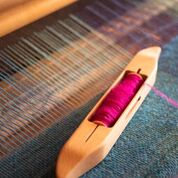
What items do you love to weave the most?
“This year I tried doing a little bit of rep weave, having been obsessed with images of it on Pinterest. But I’ve loved weaving big blankets for family and friends and also scarves and shawls. I could just play with the interaction between colour and texture for the next decade (as I have for the past decade) and still wouldn’t tire of it. “
What did you do for work before starting your business?
“I’ve had a number of career changes in my life. I started off as a community pharmacist after graduating from the University of British Columbia. And then shortly after, I transitioned into my own design business. I had started doing graphic design and web development for clients when I was still in university and so when I graduated, so slowly moved away from pharmacy work and moved towards design work. And then when I was 28 years old, I started the SweetGeorgia blog and it morphed into what it is today. I just rolled up my graphic design skills and experience into focusing entirely on SweetGeorgia. “
One of your more recent endeavours is the School of SweetGeorgia. Tell us a little bit about that.
“Yes! Two years ago, I began building an online video-based fibre arts school called the School of SweetGeorgia. The idea was to build up a deep knowledge resource of education for the full spectrum of the fibre arts. From dyeing to spinning to weaving to knitting, sprinkling in a good dose of colour theory and design content as well. The School is currently offered as a subscription-based membership that also includes an active discussion forum and monthly livestream Q&As to help support our members.
This all began when I first published my book “Dyeing to Spin & Knit” and people were inviting me to travel to teach workshops at conferences and shops all over. I have two little kids at home and didn’t want to be away from my family with all these traveling and teaching opportunities. So instead, I decided to film my teaching and workshops so that I could provide education from wherever I am to my students, wherever they happen to be. Then we can all learn and connect from wherever we are.”

What are your plans for the future of your business?
“SweetGeorgia will be celebrating its 15th anniversary in 2020 and we will be three years into the School of SweetGeorgia at that time too. Our mission has always been to bring light to people’s lives through colour and craft, and we’ve been aiming to do that through making beautiful hand-dyed yarn and fibre and designing timeless knitwear patterns for our craft community. In our future, I’d like to see us welcome more makers, weavers, spinners, dyers, and knitters to the craft community. I’d like us to use our focus on education to introduce people to a new hobby or craft that might bring their lives light and joy. “
Being based in Vancouver, Canada, what is one of your favourite places to visit?
“If you come to Vancouver, no doubt I will offer to take you to two of my favourite places — Grouse Mountain where we ski and snowboard in the winter and where my husband and I got married, and Finch’s Tea, my favourite place for sandwiches.”
**********************************************************************
Thank you for joining me here Felicia, I know my readers will be so inspired by your story, your enthusiasm and by all you do!
You can visit Felicia by following these links:
Thanks for reading friends, until next time…
Happy Weaving!
Interview with Tracy from Knit Spin Weave
Have you ever dreamed of owning a yarn shop? Tracy had that dream and made it happen!
I have known Tracy online for many years. When our children were much younger, we were involved in an online craft community, Crafty Mamas. It was a fantastic little corner of the internet where a group of women shared all manner of crafty projects and ideas. But it was more than that. It was a support and friendship group. Many of the friendships formed have continued to this day.
I would say that you are a classic “hands won’t stop” kind of creator. You are proficient in many types of fibre arts, which was the one that started it all for you?
“Knitting. My mum is a knitter and my Nan was a fabulous knitter. I was very close to my Nan as a little girl and I have very strong memories of her and her knitting. I was knitting at 5 years of age. Mum says I very quickly outstripped her skills and was knitting lace by the time I was seven. I learned to crochet when I was 7. We had immigrated to Australia and like many who came from the UK my parents had a hard time settling in their new country. They had decided to go back to the UK but didn’t want to go without seeing some of Australia first, Which is how I ended up in Gladstone, Queensland living in a caravan park. Another little girl was crocheting clothes for her Barbies and she taught me. My parents eventually came to love Australia and we did end up staying.
What attracted you to weaving? How did you learn?
Like many children I had done weaving with paper and had played with cardboard looms. Weaving as a serious interest came after I had learned to spin, I couldn’t knit fast enough to use all the yarn I was producing so I took up weaving. I went on a road trip to visit Bella Head who had a shop and studio in Adelaide and bought a wheel then loom. Bella gave me a little lesson on the wheel but mostly I learned through Interweave and YouTube videos.

How long has your shop Knit Spin Weave been open? Was it always your dream to have a shop?
Knit Spin Weave is in it’s third year. As a teenager I wanted to make my living from knitting but making money from hand knitting wasn’t a very secure income. I ended up going to College and getting a Bachelor of Education. I spent years teaching in the Northern Territory before coming back to South Australia to live. I was a stay at home mum and I took up knitting again, looking for a way to finish something. Raising a family is never something you can finish. Cleaning a house with seven children is never something you can finish. Knitting you can finish and get that satisfaction of completion.As my youngest was growing up and Centrelink were encouraging me to look at my future employment options. I knew I didn’t want to return to teaching. I didn’t have the passion, time and energy to devote to the children I would teach, so I started to think about my options. I took up a part time job which wasn’t an ideal fit and ended up with an emotional breakdown. My confidence of returning back to the workforce was severely shaken. My self worth plummeted and I had a mental crisis. About the same time, Peter my husband came out of work, Peter got shingles and a family member was diagnosed with breast cancer and we had a fire that destroyed our shed. Life just didn’t seem to be worth it anymore. I was pretty much rock bottom. The good part about being rock bottom is there is only one thing left to do and that is change.
The idea of the shop came from the ashes of my life. I was sitting in the studio and Peter came in and told me the insurance were paying us out in cash. He said, you can have half, what do you want to do with it? From nowhere the idea came, I’m going to open a shop. Even though the tough times I have never regretted that decision.
I know I am in the right place for me. I knew it as soon as I had taught my first customer/ friend to crochet and she told me about how tough life was for her at present. As she left I knew I had done something good that would make a difference in another persons life. Being creative is so important to us as human beings. I really think we need to do it for our mental well-being.

You have what many people today would consider a large family. Do you find it hard to balance business and family? Do you have any coping mechanisms to share?
Yes, it is hard to balance. I often feel selfish in having followed my dream. I especially feel guilty about my two youngest as I haven’t spent the time with them that I did with my older children. Peter is now the stay at home parent. He does the main part of the parenting. He’s the one the kids turn to for a hug and tell their troubles too. At times I feel resentful but I try to remember I had the privilege of that with the older children and it’s now Peters turn.The biggest thing I have learned is to let others help. My older children all care for the younger ones. My 16 year old son takes days off school to care for his 11 year old autistic brother. The older children all pitch in. I’m very proud of all of them. I feel incredibly blessed by the wonderful people my children are.
What are your favourite fibres to use and why?
Wool is my favourite. I love the feel of it even the strong wools. I love spinning it from raw fibre or from prepared fibre. It’s so forgiving to weave and knit with.
What single item do you seem to make the most of?
Shawls. I love knitting lace shawls. I don’t wear them. I have a rather large stash of them which made me ban myself from knitting any more. Knitting lace is mindfulness for me. When I knit lace I have to focus, I can’t let the monkey mind play or at the end of the row I am punished by the pattern being out.
There are a variety of classes running at Knit Spin Weave. Do you run the classes yourself? Do you find that your students inspire you?
I run the classes myself. I don’t have enough income to pay anyone else, plus I love teaching. I love guiding others to learn and being part of their journey. It’s a huge privilege to be someones first knitting teacher. We can all remember the person who taught us to knit.
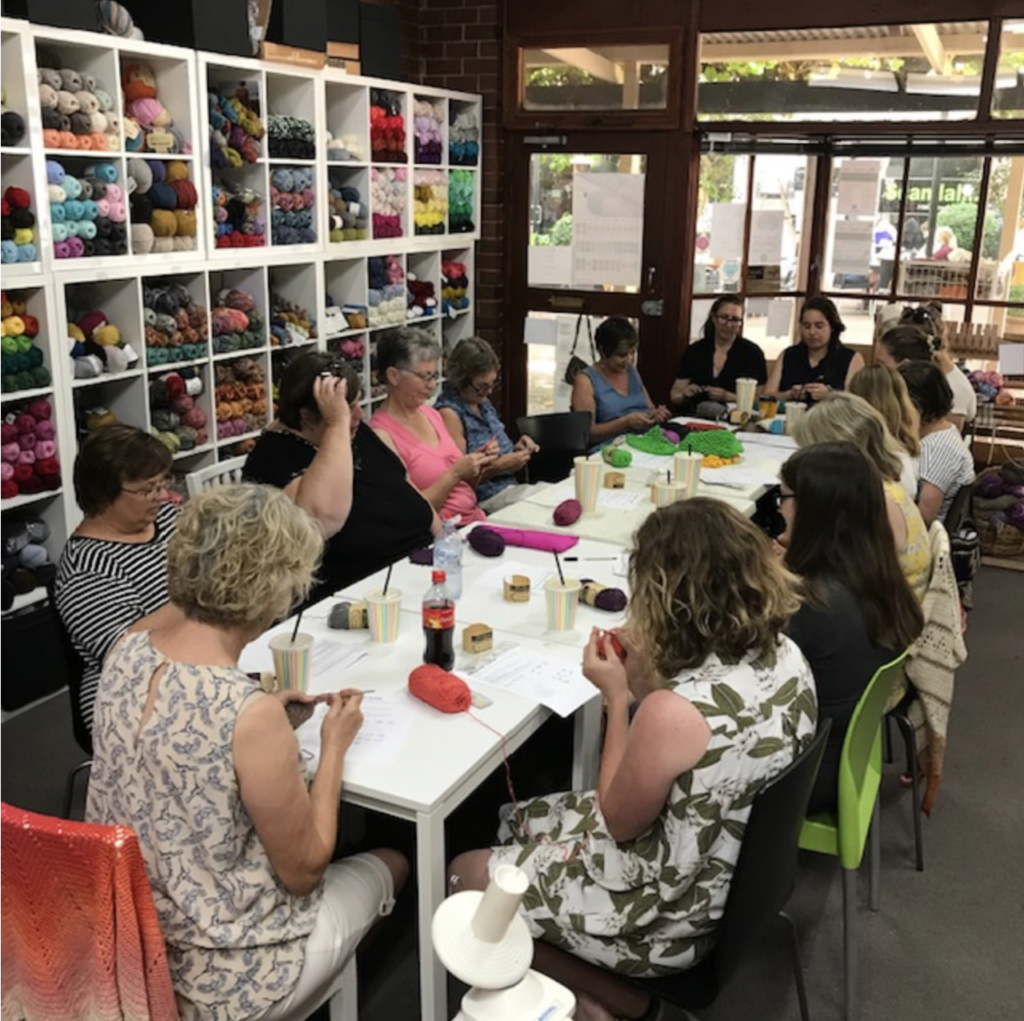
What are your hopes and plans for the future of your business?
My goal right now is just to pay myself. After that I do dream of opening a second shop in Adelaide as the kids get a bit older and start moving to the city for higher education. The online shop is something I got dragged to kicking and screaming but it does pay the bills. I try to limit my time online as it cuts into my creative time.
Being based in South Australia, what is one of your favourite places to visit?
Bundaleer Forest. I love the peace of it. When I need to get away from it all I head out there and walk under the Maples. I take my small frame looms out there and sit and weave. Weaving on small looms is like adult colouring books for me. No one really gets to see them, they don’t really have a purpose or use. They are just pure mindfulness, meditation and connection to a higher being for me.”
Thank you for sharing with us Tracy, I’m sure this interview will be an inspiration to many!
You can find the Knit Spin Weave shop at:
Shop 5/266 Main North Road, Clare 5453
There is also an online shop here
And a Facebook page here.
So, how about you? Have you ever dreamed of owning a yarn shop? Or perhaps another creative business? Let me know about it by leaving a comment, I would love to hear what your dream is!
Weaving suppliers list
Australia:
Petlins Spinning and Weaving Supplies, NSW, Ashford dealer, huge range of supplies.
BB Yarns Supply, QLD, Weaving threads and online correspondence courses.
The Thread Collective – (Affiliate link) Online supplier of threads and looms. Louet and Ashford dealer.
Crafty Frog, Canberra, ACT, Ashford dealer, looms, yarns, accessories, instore classes.
Glenora Weaving and Wool, NSW, yarns, accessories, magazines and books.
Knit, Spin, Weave, S.A, fibre arts supplies, looms, dyes, yarns, books.
Woolganics, NSW, Australian organic wool.
Aunt Jenny, Fibre arts supplies, weaving supplies, looms, Ashford dealer
New Zealand:
Ashford Handicrafts, New Zealand, large range of looms, weaving accessories, yarns and supplies.
Fibreholics, wide range of interesting yarns, classes
Wheels and whorls, Ashford dealer, huge range of looms, yarns and supplies
D.E.A. Yarns, Luxury yarns
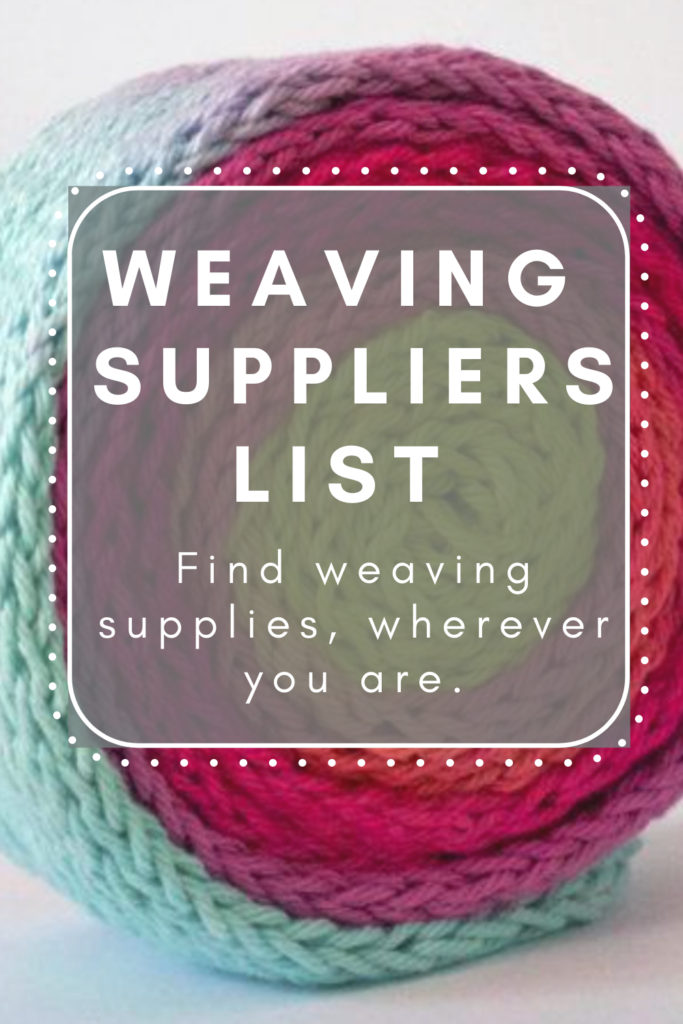
Canada:
Jane Stafford, Louet looms, spinning wheels, yarns, workshops
Penelope Fibre Arts, large range of looms, weaving supplies, yarns
Maurice Brassard, Quebec, huge range of weaving yarns
Camilla Valley Farm, Ontario, Leclerc looms, weaving yarns and supplies
USA:
The Woolery, Kentucky, huge range of everything weaving related! (Affiliate link)
WEBS, Massachusetts, Huge range also.
Revolution Fibers Looms, weaving yarns, craft kits, wheels, fibre supplies
Yarn Barn, Kansas, lots of yarn options Looms, weaving yarns, craft kits, wheels, fibre supplies
Paradise Fibres, Washington, huge range of yarns, looms and fibre art supplies
Weaving South West, New Mexico, Gallery that also stocks some small looms and varieties of yarn
Weaving Works, Seattle, looms, yarns, classes
Bountiful Weaving, large and little looms, yarns
Studio Thre3, AZ, Leclerc looms, yarns
Fibre Creek, AZ, range of looms and yarns
Heartland Fibre, Iowa, yarn (beautiful looking retail shop!)
Halcyon Yarn, looms, yarns, everything!
Lofty Fiber, weaving, knitting, spinning, yarn and classes
UK:
George Weil, looms, yarns, tapestry looms
The Handweavers Studio and Gallery, London, huge range of looms, equipment and yarns
Fibre Hut, Ashford dealer
The Threshing Barn, beautiful location in a converted spinning mill, looms, supplies and yarns
Wingham Woolwork, Wentworth, Ashford and Kromski stockist, looms, supplies, yarns
Colourmart, Online weaving yarn supplies
Hilltop Spinning and Weaving, Kent, Ashford looms, accessories, yarns
Frank Herring and Sons, Dorset, Ashford and Leclerc looms, yarns, supplies
Weft Blown, Ashford dealer, large selection of looms, weaving supplies, yarns and fibre art supplies.
Wonky Weaver , Located in Wales. Wide range of looms including Glimakra, Schacht and Louet. Spinning, dyeing and fibre arts supplies.

Spain:
https://tejoloquehilo.es/es/ – Weaving supplies, Ashford dealer, fibres for dyeing and spinning. This site is only available in Spanish or Catalan but can easily be translated with Google Chrome.
https://www.textilesnaturales.com/ – Ashford supplier but also sell Louet table and floor looms. Their website is in English and Spanish.
France:
https://www.artifilum.com/ – Ashford supplier, they also sell Glimakra, Toika and Leclerc looms. Their website is in French and English.
The Netherlands:
Stephen and Penelope – Beautiful range of knitting yarns from lace weight to bulky, big range of fibre to choose from.
Wools of Nations – Excellent range of natural knitting yarns

